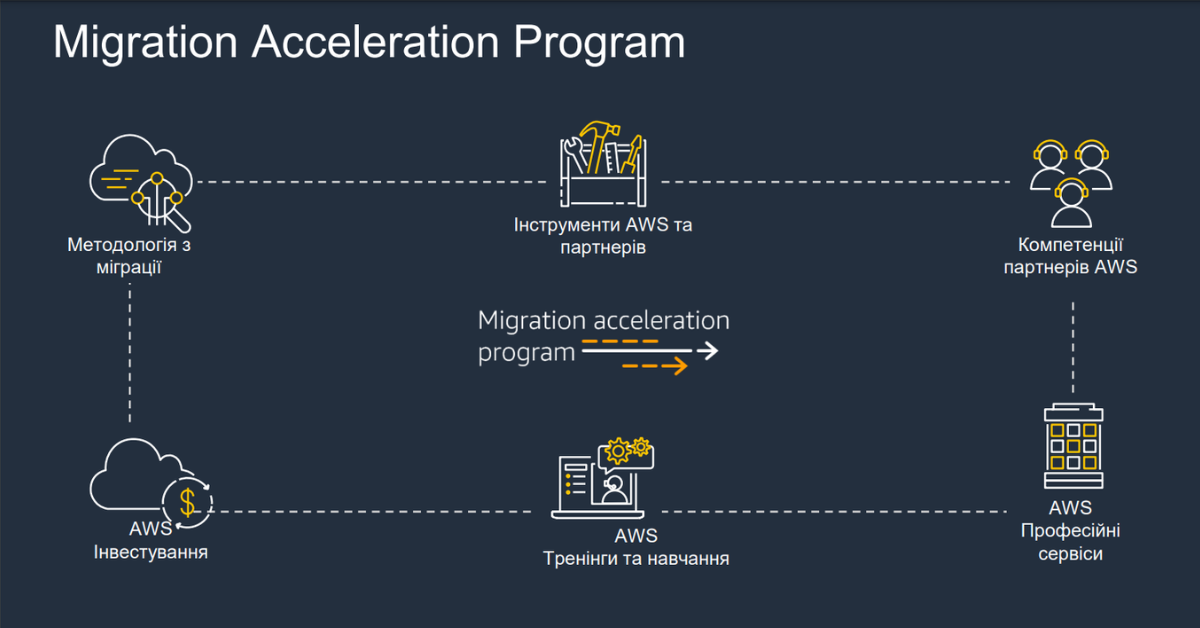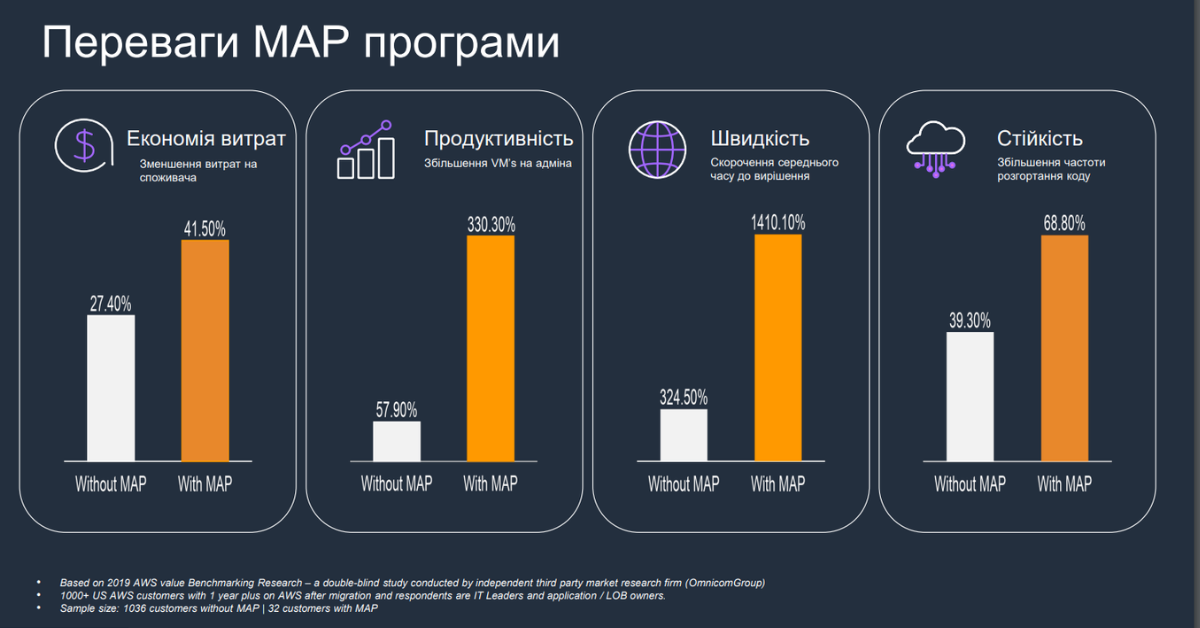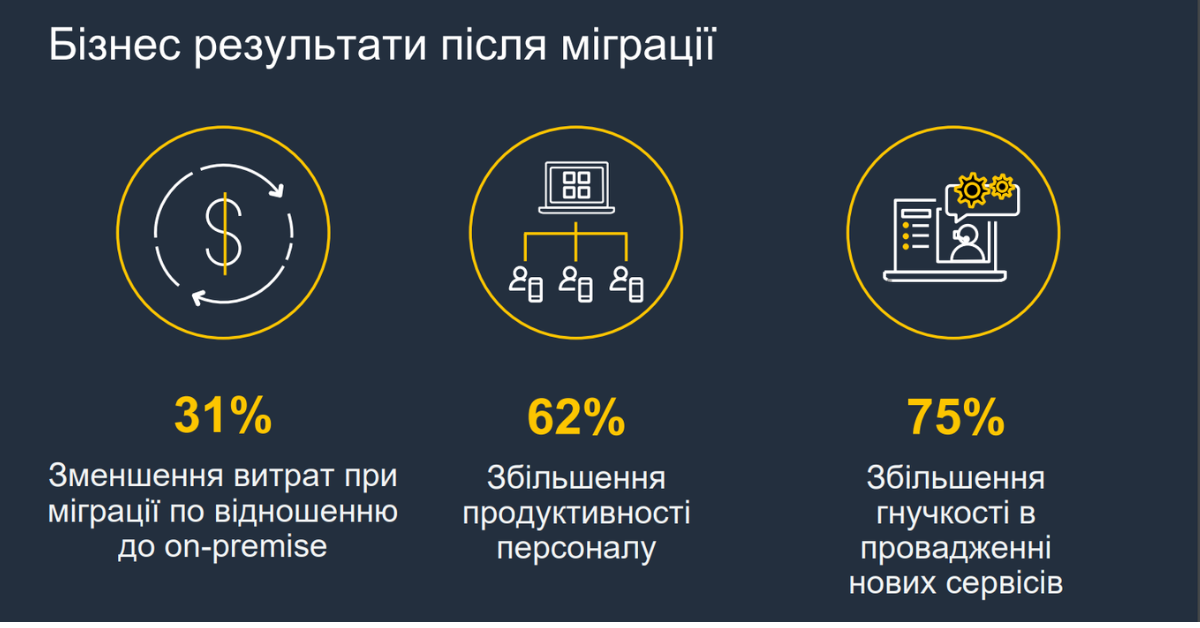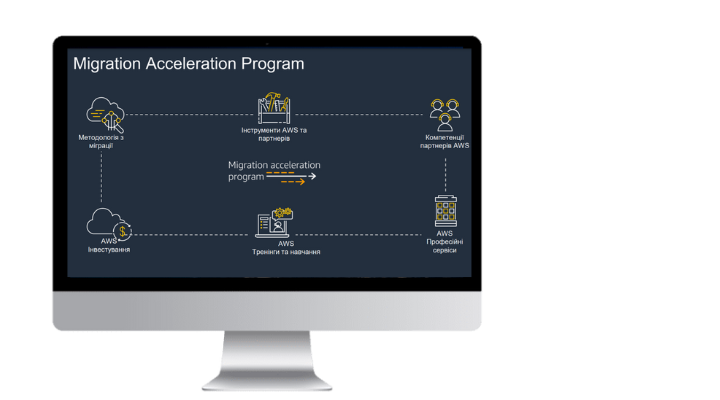AWS Migration Acceleration Program
AWS Software for fast migration without disrupting business processes
Your fast journey to the AWS Cloud
Leverage the cloud and move your infrastructure and programs to AWS without disrupting your business.
Deploying infrastructure in the Amazon Web Services (AWS) cloud provides many powerful business benefits, from reduced IT costs to flexible and nearly limitless scalability. However, making the transition is not easy without a preliminary infrastructure audit, careful planning and consistent migration. Partnering with Softprom's AWS cloud migration experts can help maximize your cost savings, business agility, and productivity in the cloud.
Softprom, Advanced Consulting Partner in the Amazon Web Services (AWS) network, with AWS MAP partner status, which is a high assessment of the competence of the company’s specialists in implementing and configuring Amazon Web Services, including for Enterprise-level companies.
Softprom adheres to the best practices of the AWS Migration Acceleration Program (MAP)
Years of experience and certified engineering competencies enable you to move your applications and workloads to the cloud quickly, efficiently, and affordably. Softprom specialists, together with the client, go through all stages of migration - from the initial strategic roadmap to the final transition to your new environment.
MAP status allows you to provide users with the following services for transforming IT infrastructure
- Detailed audit of the customer's infrastructure
- Development of a strategy and plan for migration/infrastructure modernization
- Assisting the client in the migration/upgrade process
- Free trial period
- Leveraging AWS methodologies to reduce infrastructure costs
- Training of customer employees.

3 key stages of cloud migration as part of the Migration Acceleration Program
Step 1: Assess readiness for cloud migration
An existing infrastructure audit and capacity assessment allows us to determine the capabilities required for your migration and create a TCO model for your migration project.
The migration assessment process usually gives you the following:
- Understanding where your environment is on the path to the cloud
- Understanding your current strengths and weaknesses as a cloud enterprise
- Action plan to address identified gaps.
Step 2: Mobilize your resources
Mobilization helps create a framework for your migration to address the gaps identified during the migration assessment phase.
The migration mobilization stage usually provides the following results:
- Define and automate security, risk and compliance policies for operational controls
- Define and implement an AWS landing zone that can scale while migrating additional programs
- Creating your cloud operating model
- Running applications in production facilities
Step 3: Migrate or Modernize workloads
During this phase, the actual migration process takes place using AWS best practices, tools, and processes.
Using best practices and lessons learned from previous migration phases, you can introduce a migration factory, a plan to scale implementation and operations through automation and agile delivery.
Challenges of migration projects that MAP solves:
- Pre-construction of on-premises environment
- Ensuring system performance and connectivity
- Setting up system operating processes
- Setting up policies and business rules
- Setting up security policies
- Knowledge libraries, operating principles
- Work approaches/cultural issues
- Position
Lack of methodology and random migrations cause the project to be delayed for years.
Benefits AWS Customers Receive by Working with an MAP Partner
- Development and implementation of solutions for creating a fault-tolerant infrastructure individually for the customer’s tasks (as a result - a significant reduction in emergency incidents in the operation of the infrastructure)
- Increasing the productivity of customer IT personnel through infrastructure automation using AWS services
- Reducing the time to deploy new services and company solutions
- Reducing customer infrastructure costs.

Softprom engineers, based on their many years of experience, have identified 3 key reasons why you should migrate to the cloud.
- The ability to create a modern fault-tolerant infrastructure with maximum reliability and the ability to quickly recover data under various force majeure circumstances.
- Significant time savings for implementing innovative solutions.
- Significant economic effect, which is determined by the absence of capital costs - only operating expenses, cost optimization using AWS tools and support programs.

Softprom has received a number of AWS migration competencies and Migration Acceleration Program (MAP) status due to its extensive experience spanning many successful migrations to AWS from on-premises environments, hosting providers, and other public cloud providers. Our cloud migration services use the latest tools and technologies provided by AWS, along with our in-house expert engineers and DevOps developers, to ensure a smooth migration completion without any disruption to your services.
Typical migration use cases
- Server&Data Migrations. Migrate workloads from on-premises infrastructure, Google Cloud, or other cloud platforms to AWS, and move large on-premises data sets to the cloud
- Application Migrations. Quickly migrate hundreds of programs to AWS without disrupting critical operations
- Database Migrations. Migrate all your organization's data from commercial and public databases without leakage.
Softprom — Advanced Consulting Partner on the Amazon Web Services network. Has MAP (Migration Acceleration Program) status as an AWS partner and carries out infrastructure migration projects to the cloud for Enterprise level companies.
Features
More opportunities in the cloud with Softprom and AWS
REDUCE OPERATING COSTS
fees for used services, volume discounts
INCREASING BUSINESS FLEXIBILITY
accelerate innovation, reduce time to market
LESS RISKS, INCREASED SAFETY
implement necessary security, governance and compliance policies






